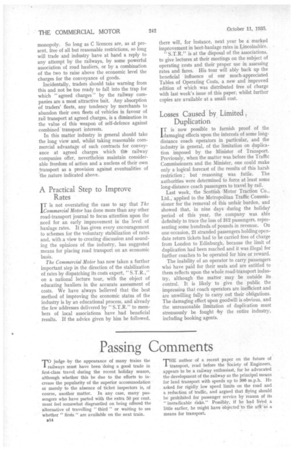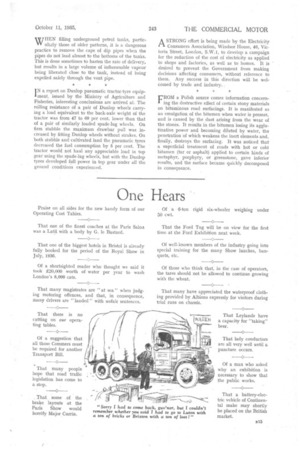Passing Comments
Page 28

Page 29

If you've noticed an error in this article please click here to report it so we can fix it.
Tjudge by the appearance of many trains the railways must have been doing a good trade in first-class travel during the recent holiday season, although whether this be due to the efforts to increase the popularity of the superior accommodation or merely to the absence of ticket inspectors is, of course, another matter. In any case, many passengers who have parted with the extra 50 per cent. must feel somewhat disgruntled on being offered the alternative of travelling " third " or waiting to see whether " firsts" are available on the next train.
14
THE author of a recent paper on the future of transport, read before the Society of Engineers, appears to be a railway enthusiast, for he advocated the development of the railway as the principal means for land transport with speeds up to 300 m.p.h. He asked for rigidly low speed limits on the road and a reduction of traffic, and argued that flying should be prohibited for passenger service by reason of its " ineradicable risks." Possibly, if he had filled a little earlier, he might have objected to the ark aS a means for transport. WHEN filling underground petrol tanks, particularly those of older patterns, it is a dangerous practice to remove the caps of dip pipes when the pipes do not lead almost to the bottoms of the tanks. This is done sometimes to hasten the rate of delivery, but results in a large volume of inflammable vapour being liberated close to the tank, instead of being expelled safely through the vent pipe.
I N a report on Dunlop pneumatic tractor-tyre equip ment, issued by the Ministry of Agriculture and Fisheries, interesting conclusions are arrived at. The rolling resistance of a pair of Dunlop wheels carrying a load equivalent to the back-axle weight of the tractor was from 47 to 69 per cent. lower than that of a pair of similarly loaded spade-lug wheels. On firm stubble the maximum drawbar pull was increased by fitting Dunlop wheels without strakes. On both stubble and cultivated land the pneumatic tyres decreased the fuel consumption by 5 per cent. The tractor would not haul any appreciable load in top gear using the spade-lug wheels, but with the Dunlop tyres developed full power in top gear tinder all the ground conditions experienced.
A STRONG effort is being made by the Electricity ra Consumers Association, Windsor House, 46, Victoria Street, London, S.W.1, to develop a campaign for the reduction of the cost of electricity as applied to shops and factories, as well as to homes. It is desired to prevent the Government from making decisions affecting consumers, without reference to them. Any success in this direction will be welcomed by trade and industry..
FROM a Polish source comes information concerning the destructive effect of certain stony materials on bituminous road surfacings. It is manifested as an emulgation of the bitumen when water is present, and is caused by the dust arising from the wear of the stones. It results in the bitumen losing its agglutinative power and becoming diluted by water, the penetration of which weakens the inert elements and, finally, destroys the surfacing. It was noticed that a superficial treatment of roads with hot or cold bitumen (tar or asphalt) applied to certain kinds of metaphyr, porphyry, or greenstone, gave inferior results, and the surface became quickly decomposed in consequence.




























































































